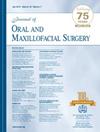Coronectomy in Lower Third Molar Surgery: A Systematic Review and Meta-Analysis
IF 2.3
3区 医学
Q2 DENTISTRY, ORAL SURGERY & MEDICINE
引用次数: 0
Abstract
Purpose
Coronectomy is an alternative approach to the complete removal of an impacted mandibular third molar. The present study conducted a systematic review and meta-analysis to compare coronectomy with extraction concerning complications associated with the inferior alveolar nerve injury (IANI).
Methods
This review followed the principles of systematic reviews and meta-analyses. We conducted a comprehensive literature search of 5 databases according to PRISMA guidelines. Research articles published in English before April 30, 2024 were reviewed. The keywords consisted of “coronectomy and lower third molar.” In this study, Rayyan online software was used to identify and eliminate duplicate articles, and another reviewer was invited to screen the articles independently. The included articles' data were extracted, and conclusions were drawn after cross-comparison. The forest plot was drawn after analysis by the R program (JJ Allaire, Boston, Massachusetts, USA). The primary outcome variable of the present study was evaluating the incidence of IANI, and secondly, the lingual nerve injury (LNI), dry socket, postoperative infection, the necessity for surgical reintervention, root migration, root extraction, and coronectomy failure rate. These assessments were made concerning patients' chosen operative technique for managing third molars, either coronectomy or extraction, as predictor variables.
Results
After applying inclusion and exclusion criteria, 34 of the 564 articles were included in this study (24 cohort studies and 10 case‒control studies), with 7,115 wisdom teeth from 4,477 patients in different countries. Meta-analysis showed that coronectomy reduced the risk of IANI: relative risk (RR): 0.1; 95% confidence interval (CI): 0.0-0.2; I2 (inconsistency index) = 0%; P < .0001, the risk of LNI (RR: 0.2; 95% CI: 0.0-0.7; I2 = 0%; P = .01), dry socket (RR: 0.4; 95% CI: 0.3-0.7; I2 = 0%; P = .002), and postoperative infection (RR: 1.0; 95% CI: 0.5-2.1; I2 = 27%; P = .9). However, coronectomy exhibited a higher risk of surgical reintervention of 3.63% (111 of 3,055), root exposure of 2.66% (61 of 2,290), and a specific failure rate of 2.79% (119 of 4,261).
Conclusion
When the mandibular third molar with a higher risk of IANI needs to be removed, coronectomy can reduce the risk of IANI and LNI and the incidence of dry socket compared with traditional extraction. There was no significant difference in postoperative infection between the 2 groups. However, coronectomy exhibited a specific failure rate and higher odds of secondary surgical intervention. Guided bone regeneration can slow down the movement of residual roots and reduce the incidence of secondary surgery.
下第三磨牙冠切除术:系统回顾和荟萃分析。
目的:冠状切除术是完全去除下颌阻生第三磨牙的另一种方法。本研究进行了系统回顾和荟萃分析,比较冠状切除术和拔牙术对下牙槽神经损伤(IANI)相关并发症的影响。方法:本综述遵循系统综述和荟萃分析的原则。我们根据PRISMA指南对5个数据库进行了全面的文献检索。对2024年4月30日前发表的英文研究论文进行了综述。关键词为“冠状切除和下第三磨牙”。本研究采用Rayyan在线软件识别和消除重复文章,并邀请另一位审稿人独立筛选文章。提取纳入文献的资料,交叉比较得出结论。森林样地是由R程序(JJ Allaire, Boston, Massachusetts, USA)分析后绘制的。本研究的主要结局变量是评估IANI的发生率,其次是舌神经损伤(LNI)、干窝、术后感染、手术再干预的必要性、根迁移、根拔出和冠状切除术的失败率。这些评估是关于患者选择的第三磨牙手术技术,无论是冠切除术还是拔牙,作为预测变量。结果:应用纳入和排除标准后,564篇文献中有34篇纳入本研究(24篇队列研究和10篇病例对照研究),涉及不同国家4477例患者的7115颗智齿。荟萃分析显示,冠状切除术降低了IANI的风险:相对风险(RR): 0.1;95%置信区间(CI): 0.0-0.2;I2(不一致性指数)= 0%;p 2 = 0%;P = 0.01)、干槽(RR: 0.4;95% ci: 0.3-0.7;i2 = 0%;P = 0.002),术后感染(RR: 1.0;95% ci: 0.5-2.1;i2 = 27%;p = .9)。然而,冠状切除术显示出更高的手术再干预风险,为3.63%(3055例中的111例),牙根暴露为2.66%(2290例中的61例),特定失败率为2.79%(4261例中的119例)。结论:下颌第三磨牙IANI危险性较高,需要拔除时,与传统拔牙相比,冠状切除术可降低IANI和LNI的危险性及干槽的发生率。两组术后感染发生率无显著差异。然而,冠状切除术显示出特定的失败率和更高的二次手术干预几率。引导骨再生可以减缓残根的运动,减少二次手术的发生。
本文章由计算机程序翻译,如有差异,请以英文原文为准。
求助全文
约1分钟内获得全文
求助全文
来源期刊

Journal of Oral and Maxillofacial Surgery
医学-牙科与口腔外科
CiteScore
4.00
自引率
5.30%
发文量
0
审稿时长
41 days
期刊介绍:
This monthly journal offers comprehensive coverage of new techniques, important developments and innovative ideas in oral and maxillofacial surgery. Practice-applicable articles help develop the methods used to handle dentoalveolar surgery, facial injuries and deformities, TMJ disorders, oral cancer, jaw reconstruction, anesthesia and analgesia. The journal also includes specifics on new instruments and diagnostic equipment and modern therapeutic drugs and devices. Journal of Oral and Maxillofacial Surgery is recommended for first or priority subscription by the Dental Section of the Medical Library Association.
 求助内容:
求助内容: 应助结果提醒方式:
应助结果提醒方式:


